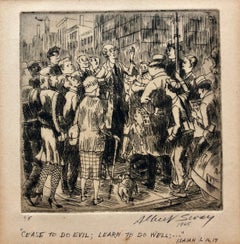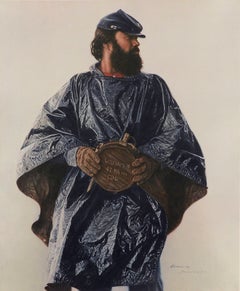Albert Sway Prints and Multiples
to
2
Overall Width
to
Overall Height
to
1
13
1,218
958
918
835
2
1
1
1
1
1
1
1
1
1
1
1
2
Artist: Albert Sway
Black Broadway Street Dancers
Located in Wilton Manors, FL
Beautiful WPA era NYC street scene by American artist, Albert Sway (b.1913). Jiggers on Broadway, ca. 1935. Lithograph on paper, image measures 9 x 13 inches. Full sheet measuring 11...
Category
1930s American Realist Albert Sway Prints and Multiples
Materials
Paper, Ink
New York Social Realist Etching Cease To Do Evil Learn To Do Well WPA Artist NYC
Located in Surfside, FL
18.5x15.5, 6.25 x 5 mat cut size. edition 1/6 signed and dated.
Albert Sway (b.1913)
Painter, illustrator, etcher, lithographer, cartoonist and teacher, Albert Sway was born in Cin...
Category
1960s American Modern Albert Sway Prints and Multiples
Materials
Etching
Related Items
"The Volunteer - Civil War" Historical Portrait, 742/1500
Located in Soquel, CA
Limited edition offset print of the original photorealistic painting, a portrait that portrays a historical reenactment of a civil war volunteer by James Bama...
Category
1980s American Realist Albert Sway Prints and Multiples
Materials
Paper, Ink, Offset
$675
H 26.5 in W 22 in D 0.13 in
Meditation and Minou
By Will Barnet
Located in Buffalo, NY
Artist: Will Barnet, American (1911 - 2012)
Title: Meditation and Minou
Year: 1980
Medium: Lithograph and Serigraph on BFK Rives, signed and numbered in pencil
Edition: 40/150
Category
1970s American Realist Albert Sway Prints and Multiples
Materials
Archival Paper, Lithograph
Manhattan Mountains
By Lawrence Wilbur
Located in Storrs, CT
Manhattan Mountains. 1938. Etching and drypoint. 14 3/4 x 12 3/8 (sheet 17 1/4 x 14 3/4). Artist proof, previous to the edition of 40. An atmospheric impression printed on buff-colored laid paper. Signed and dated in the plate. Signed, titled, and annotated 'Final state' and 'Jones Proof'in pencil. Housed in an archival sleeve.
Painter and printmaker Lawrence Nelson...
Category
20th Century American Modern Albert Sway Prints and Multiples
Materials
Drypoint, Etching
"End of Day" Original Limited Edition Etching
Located in Soquel, CA
"End of Day" Original Limited Edition Etching by John McGrath (Irish/American b.1884 d.1942).
This etching depicts a man with a tool slung over his shoulder walking along a path th...
Category
Early 20th Century American Realist Albert Sway Prints and Multiples
Materials
Paper, Ink, Drypoint, Etching
"The Slope Near the Bridge" Paul Sample, Mid-Century, American Snowy Landscape
By Paul Sample
Located in New York, NY
Paul Sample
The Slope Near the Bridge, 1950
Signed in pencil lower left
Lithograph on wove paper
Image 8 15/16 x 12 15/16 inches
Sheet 11 5/16 x 15 1/16 inches
From the edition of 25...
Category
1950s American Realist Albert Sway Prints and Multiples
Materials
Paper, Lithograph
$900
H 16.25 in W 20.25 in
Shadows on the Ramp
By Martin Lewis
Located in Storrs, CT
Shadows on the Ramp. 1927. Drypoint and sand ground. McCarron 64. 9 x 10 1/2 (sheet 12 3/8 x 14). Edition 75 recorded impressions. A rich, tonal impression with drypoint burr, printe...
Category
1920s American Modern Albert Sway Prints and Multiples
Materials
Drypoint, Etching
The Spire -- New York
By Lawrence Wilbur
Located in Storrs, CT
The Spire -- New York. 1985. Etching and drypoint. 14 1/2 x 11 (sheet 22 1/2 x 18). Trial proof of the second third, prior to the edition of 100. Printed on Rives cream wove paper, on the full sheet with deckle edges. A rich impression in pristine condition, housed in an archival sleeve. This etching has never been matted. Provenance: the artist's estate. Titled, annotated 'third state - trial proof' and signed in pencil. A dramatic view of the Chrysler Building.
Painter and printmaker Lawrence Nelson...
Category
20th Century American Modern Albert Sway Prints and Multiples
Materials
Drypoint, Etching
Night Shadows
By Edward Hopper
Located in Storrs, CT
Night Shadows. 1921. Etching. Levin 82. 7 x 8 3/8 (sheet 10 x 13 7 1/16).s Series: Six American Etchings: The New Republic Portfolio, 1924. Edition approximately 500-600. Illustrate...
Category
1920s American Modern Albert Sway Prints and Multiples
Materials
Etching
“Mobile (The Inventor), 1953” Paul Cadmus Magical Realism Serigraph Signed
By Paul Cadmus
Located in Yardley, PA
“Mobile (The Inventor), 1953” by Paul Cadmus (American, 1904-1999).
A figure painter known from the 1930s on for his baldly satirical commentaries on human appetites and desires, Ca...
Category
1950s American Realist Albert Sway Prints and Multiples
Materials
Paper
$3,500
H 25.75 in W 28 in D 1 in
Building a Babylon, Tudor City, NY.
By Martin Lewis
Located in Storrs, CT
McCarron 76. 12 7/8 x 7 7/8 (sheet 16 5/8 x 12 1/4). 6th trial proof (McCarron records 84 impressions including 4 trial proofs). Illustrated L'Amérique de la Dépression: Artistes En...
Category
Early 20th Century American Modern Albert Sway Prints and Multiples
Materials
Drypoint, Etching
$11,000 Sale Price
26% Off
H 24.5 in W 20 in D 1 in
Stoops in Snow
By Martin Lewis
Located in Storrs, CT
Stoops in Snow. 1930. Drypoint and sandpaper ground. McCarron catalog 89.state ii. 9 x 14 7/8 (sheet 13 1/4 x 18 7/16 ). Edition 115 recorded impressio...
Category
1930s American Modern Albert Sway Prints and Multiples
Materials
Drypoint, Etching
OPHELIA (the artist's mistress / second wife) - In Celebration of Pride Month
By Gerald Leslie Brockhurst
Located in New Orleans, LA
This elegant etching titled the gilded youth is of the second wife of the artist The edition is 75 and is referenced as Fletcher #80.
Gerald Brockhurst is best known for his portr...
Category
1940s American Modern Albert Sway Prints and Multiples
Materials
Etching
$4,810 Sale Price
26% Off
H 10.88 in W 8.88 in
Previously Available Items
New York Social Realist Etching Cease To Do Evil Learn To Do Well WPA Artist NYC
Located in Surfside, FL
18.5x15.5, 6.25 x 5 mat cut size. edition 1/6 signed and dated.
Albert Sway (b.1913)
Painter, illustrator, etcher, lithographer, cartoonist and teacher, Albert Sway was born in Cin...
Category
1960s American Modern Albert Sway Prints and Multiples
Materials
Etching
Albert Sway prints and multiples for sale on 1stDibs.
Find a wide variety of authentic Albert Sway prints and multiples available for sale on 1stDibs. You can also browse by medium to find art by Albert Sway in etching and more. Much of the original work by this artist or collective was created during the 1960s and is mostly associated with the modern style. Not every interior allows for large Albert Sway prints and multiples, so small editions measuring 5 inches across are available. Customers who are interested in this artist might also find the work of Bernard Brussel-Smith, Walt Kuhn, and John DePol. Albert Sway prints and multiples prices can differ depending upon medium, time period and other attributes. On 1stDibs, the price for these items starts at $500 and tops out at $500, while the average work can sell for $500.



